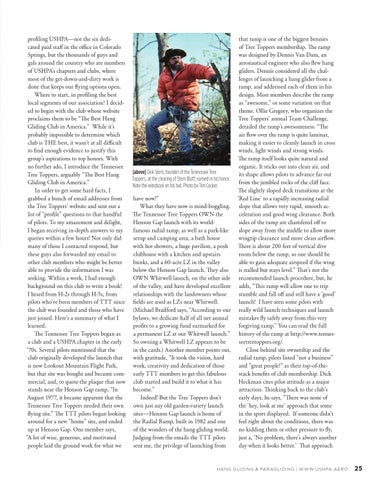profiling USHPA—not the six dedicated paid staff in the office in Colorado Springs, but the thousands of guys and gals around the country who are members of USHPA’s chapters and clubs, where most of the get-down-and-dirty work is done that keeps our flying options open. Where to start, in profiling the best local segments of our association? I decided to begin with the club whose website proclaims them to be “The Best Hang Gliding Club in America.” While it’s probably impossible to determine which club is THE best, it wasn’t at all difficult to find enough evidence to justify this group’s aspirations to top honors. With no further ado, I introduce the Tennessee Tree Toppers, arguably “The Best Hang Gliding Club in America.” In order to get some hard facts, I grabbed a bunch of email addresses from the Tree Toppers’ website and sent out a list of “profile” questions to that handful of pilots. To my amazement and delight, I began receiving in-depth answers to my queries within a few hours! Not only did many of those I contacted respond, but these guys also forwarded my email to other club members who might be better able to provide the information I was seeking. Within a week, I had enough background on this club to write a book! I heard from H-2s through H-5s, from pilots who’ve been members of TTT since the club was founded and those who have just joined. Here’s a summary of what I learned. The Tennessee Tree Toppers began as a club and a USHPA chapter in the early ‘70s. Several pilots mentioned that the club originally developed the launch that is now Lookout Mountain Flight Park, but that site was bought and became commercial, and, to quote the plaque that now stands near the Henson Gap ramp, “In August 1977, it became apparent that the Tennessee Tree Toppers needed their own flying site.” The TTT pilots began looking around for a new “home” site, and ended up at Henson Gap. One member says, “A lot of wise, generous, and motivated people laid the ground work for what we
[above] Dick Stern, founder of the Tennessee Tree Toppers, at the clearing of Stern Bluff, named in his honor. Note the windsock on his hat. Photo by Tim Cocker.
have now!” What they have now is mind-boggling. The Tennessee Tree Toppers OWN the Henson Gap launch with its worldfamous radial ramp, as well as a park-like setup and camping area, a bath house with hot showers, a huge pavilion, a posh clubhouse with a kitchen and upstairs bunks, and a 60-acre LZ in the valley below the Henson Gap launch. They also OWN Whitwell launch, on the other side of the valley, and have developed excellent relationships with the landowners whose fields are used as LZs near Whitwell. (Michael Bradford says, “According to our bylaws, we dedicate half of all net annual profits to a growing fund earmarked for a permanent LZ at our Whitwell launch.” So owning a Whitwell LZ appears to be in the cards.) Another member points out, with gratitude, “It took the vision, hard work, creativity and dedication of those early TTT members to get this fabulous club started and build it to what it has become.” Indeed! But the Tree Toppers don’t own just any old garden-variety launch sites—Henson Gap launch is home of the Radial Ramp, built in 1982 and one of the wonders of the hang gliding world. Judging from the emails the TTT pilots sent me, the privilege of launching from
that ramp is one of the biggest bennies of Tree Toppers membership. The ramp was designed by Dennis Van Dam, an aeronautical engineer who also flew hang gliders. Dennis considered all the challenges of launching a hang glider from a ramp, and addressed each of them in his design. Most members describe the ramp as “awesome,” or some variation on that theme. Ollie Gregory, who organizes the Tree Toppers’ annual Team Challenge, detailed the ramp’s awesomeness: “The air flow over the ramp is quite laminar, making it easier to cleanly launch in cross winds, light winds and strong winds. The ramp itself looks quite natural and organic. It sticks out into clean air, and its shape allows pilots to advance far out from the jumbled rocks of the cliff face. The slightly sloped deck transitions at the ‘Red Line’ to a rapidly increasing radial slope that allows very rapid, smooth acceleration and good wing clearance. Both sides of the ramp are chamfered off to slope away from the middle to allow more wingtip clearance and more clean airflow. There is about 200 feet of vertical dive room below the ramp, so one should be able to gain adequate airspeed if the wing is stalled but stays level.” That’s not the recommended launch procedure, but, he adds, “This ramp will allow one to trip stumble and fall off and still have a ‘good’ launch! I have seen some pilots with really wild launch techniques and launch mistakes fly safely away from this very forgiving ramp.” You can read the full history of the ramp at http://www.tennesseetreetoppers.org/. Close behind site ownership and the radial ramp, pilots listed “not a business” and “great people!” as their top-of-thestack benefits of club membership. Dick Heckman cites pilot attitude as a major attraction. Thinking back to the club’s early days, he says, “There was none of the ‘hey, look at me’ approach that some in the sport displayed. If someone didn’t feel right about the conditions, there was no kidding them or other pressure to fly, just a, ‘No problem, there’s always another day when it looks better.’ That approach
HANG GLIDING & PAR AGLIDING | WWW.USHPA . AERO
25
